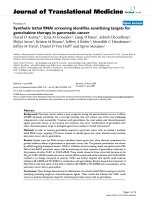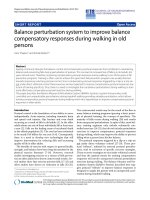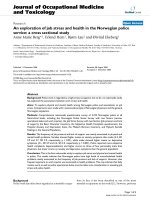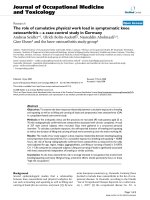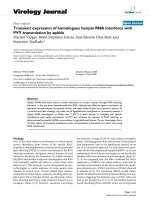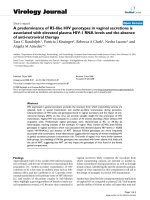Báo cáo hóa học: " Avoiding Loss of Catalytic Activity of Pd Nanoparticles Partially Embedded in Nanoditches in SiC Nanowires'''' doc
Bạn đang xem bản rút gọn của tài liệu. Xem và tải ngay bản đầy đủ của tài liệu tại đây (439.71 KB, 6 trang )
NANO EXPRESS
Avoiding Loss of Catalytic Activity of Pd Nanoparticles Partially
Embedded in Nanoditches in SiC Nanowires
Xiao-Ning Guo
•
Ru-Jing Shang
•
Dong-Hua Wang
•
Guo-Qiang Jin
•
Xiang-Yun Guo
•
K. N. Tu
Received: 28 September 2009 / Accepted: 28 October 2009 / Published online: 15 November 2009
Ó to the authors 2009
Abstract Nanoditches from selective etching of periodi-
cally twinned SiC nanowires were employed to hinder the
migration and coalescence of Pd nanoparticles supported
on the nanowires, and thus to improve their catalytic sta-
bility for total combustion of methane. The results show
that the etched Pd/SiC catalyst can keep the methane
conversion of almost 100% while the unetched one has an
obvious decline in the catalytic activity from 100 to 82%
after ten repeated reaction cycles. The excellent catalytic
stability originates from the limitation of the nanoditches to
the migration and growth of Pd nanoparticles.
Keywords SiC nanowires Á Selective etching Á
Pd nanoparticles Á High catalytic stability
Introduction
Noble metal nanoparticles dispersed on inert supports
usually exhibit high chemical activity in heterogeneous
catalyst as well as fuel cell applications. However, the
metal nanoparticles migrate and aggregate easily on the
supports, thus their chemical activity decreases rapidly.
For example, the growth of Pt nanoparticles in the cathode
catalyst of fuel cell is one of the major factors resulting in
the degradation of catalytic performance [1, 2]. Au
nanoparticles with a size below 5 nm exhibit very high
catalytic activity, and their catalytic activity shows a sharp
reduction when the particle size becomes larger than 5 nm
[3, 4]. Similarly, the increase in activity of Pd-based cat-
alysts is found to depend on the decrease of the size of
PdO crystallites [5, 6]. In addition, the deactivation of
catalysts can be aggravated by the coke deposition, which
is formed more easily over larger metal particles [7].
Therefore, the control of migration and aggregation of
metal nanoparticles on the supports remains a challenging
problem in heterogeneous catalysis. Recently, different
routes have been proposed to improve their stability. The
Somorjai group designed a high-temperature-stable model
catalytic system consisting of a Pt core coated with a
mesoporous silica shell and found that the core–shell
particles exhibited high catalytic activity and stability [8].
The same group also proposed to stabilize Rh nanoparticle
catalyst using poly(vinylpyrrolidone) for CO oxidation [9].
The Xia group designed Pt–Pd bimetallic nanodendrites to
stabilize Pt nanoparticles [10]. In industrial catalysts, a
practicable solution to the problem is to enhance the
interaction between metals and supports by modification
of the support surface; however, the metal nanoparticles
may react with the supports or modifiers to form low-
activity phases, and resulting in a decrease of their cata-
lytic activity [11, 12].
Catalytic combustion of methane is the process in which
methane is oxidized to CO
2
and H
2
O at a low temperature.
It is a promising solution to the removal of low-concen-
tration methane from gas mixtures due to lower emissions
X N. Guo Á R J. Shang Á D H. Wang Á G Q. Jin Á
X Y. Guo (&)
State Key Laboratory of Coal Conversion, Institute of Coal
Chemistry, 030001 Taiyuan, People’s Republic of China
e-mail:
K. N. Tu (&)
Department of Materials Science and Engineering,
University of California at Los Angeles, Los Angeles,
CA 90095-1595, USA
e-mail:
X N. Guo Á R J. Shang
Graduate University of the Chinese Academy of Sciences,
100039 Beijing, People’s Republic of China
123
Nanoscale Res Lett (2010) 5:332–337
DOI 10.1007/s11671-009-9484-6
of NO
x
, CO, and unburned hydrocarbons [13, 14]. Sup-
ported Pd catalysts have been found to have excellent
catalytic activity for the process, and the supports gener-
ally are oxides, such as SiO
2
,Al
2
O
3
, silica-alumina, and
different zeolithic frameworks [13, 14]. However, the
catalytic combustion of methane is a strongly exothermic
reaction, which requires that the supports can disperse the
reaction heat efficiently. Unfortunately, the supports
mentioned earlier are thermal insulators and the reaction
heat accumulated on isolated metal nanoparticles makes
them sintered together easily. Therefore, the reactions
between the Pd nanoparticles and the supports remain a
problem [11, 12]. To solve this problem, thermal con-
ductive SiC and Si
3
N
4
have been employed as the catalyst
supports [15, 16]. Yet, Pd nanoparticles migrate and coa-
lesce easily on SiC or Si
3
N
4
surfaces, resulting in a
decrease in catalytic activity again.
Cubic SiC nanowires usually contain a high density of
periodical stacking faults perpendicular to the growth
direction [17–20]. These stacking faults enable the
nanowires to have different acid resistance from the
regions between the faults. By selective etching, different
research groups have prepared a variety of patterned SiC
nanostructures [21–23]. In our previous work, it was
found that the periodically twinned SiC nanowires could
be converted into periodically nanoditched nanowires by
HNO
3
? HF etching [19]. Therefore, we think that the
nanoditched nanowires can be used to design a novel
nanostructured catalyst by assembling metal nanoparticles
into the nanoditched SiC nanowires, as shown in
Scheme 1. The nanoditched nanostructure is expected to
hinder the migration and coalescence of metal nanopar-
ticles on the nanowire supports, in turn to achieve a stable
catalytic activity.
In this work, we employed nanoditched SiC nanowires
to design the catalyst for catalytic combustion of methane
and demonstrated that the novel nanostructures can effec-
tively hinder the migration and growth of Pd nanoparticles
and has greatly improved their catalytic stability.
Experimental Section
Periodically twinned SiC nanowires were prepared by the
carbothermal reduction of a carbonaceous silica xerogel
precursor from tetraethoxysilane and biphenyl [19]. The
nanowires were etched in the mixture of HF (38–40%) and
HNO
3
(65%) solutions with a volume ratio of 3:1 at 60°C
for 10 min and 85°C for 30 min, respectively. After etch-
ing, the nanowires were washed with deionized water and
dried at 110°C. The impregnation method was used to
prepare Pd/SiC catalyst. Firstly, 0.4 g of the etched or
unetched SiC was added into 20 ml of Pd(NO
3
)
2
Á2H
2
O
aqueous solution (0.05 wt.%) under stirring for 12 h.
Afterward, the mixture was dried at 110°C for 12 h and
then calcined in air at 500°C for 4 h. By this method, the
catalyst has a Pd loading of 1 wt.%.
The catalytic performance of the Pd/SiC catalysts were
tested in a fixed-bed quartz reactor with an inner diameter
of 8 mm at atmospheric pressure, and the mixture of O
2
(20%)/CH
4
(1%)/N
2
(79%) was used as the feedstock. A
weight of 300 mg of the catalyst was packed between two
layers of quartz wool. The hourly space velocity was
controlled to be 12,000 h
-1
. Since the deactivation of a
supported SiC catalyst usually demands a long time, a
cyclic reaction method was used to estimate the catalyst
stability. In this method, the catalyst was programmed
heated to a temperature at which the reaction obtained a
near 100% methane conversion. In the heating process, the
methane conversion was measured at different temperature.
Afterward, the reactor was cooled down to the temperature
at which the catalyst just became inactive, and then the
next reaction cycle began again.
The fresh and used catalysts were studied by transmis-
sion electron microscopy (TEM, JEM-2010). The sample
was firstly ultrasonically dispersed in ethanol for 20 min.
Afterward, a droplet of the suspension was dropped to a
lacey carbon-coated copper grid and dried for TEM
observation.
Results and Discussion
The SiC nanowires, having a hexagonal cross section, are
characterized by a zigzag arrangement of periodically
twinned segments with a rather uniform thickness along the
entire growth length. According to our previous work [19],
the zigzag nanowires are formed by periodical twins, and
the rotation angle of two neighboring cubic segments is
141°, which is twice the interplanar angle of 70.5° between
{111} planes. The HF and HNO
3
mixture etches the cubic
segments between the twin boundaries. The unetched twin
boundaries thus become separated platelets or fins standing
on the etched nanowires. Therefore, the etched nanowires
Scheme 1 Schematic diagram of the novel nanostructured catalyst:
Pd nanoparticles are anchored in the ditches of the nanowires
Nanoscale Res Lett (2010) 5:332–337 333
123
show a morphology of repeating fins as reported in litera-
ture [19, 22]. However, the etched sample under the
etching condition of 60°C for 10 min did not show a fin-
like structure, instead many shallow nanoditches were
formed, and these nanoditches were distributed periodi-
cally on the entire nanowires (see Fig. 1). This is because
the present etching is carried out at a lower temperature
and in a shorter time.
Figure 1 shows TEM images of the as-prepared Pd/SiC
catalyst (etched at 60° C for 10 min). In Fig. 1a, it can be
seen that homogeneous Pd nanoparticles are dispersed on
the nanowire surface. Moreover, almost all the Pd nano-
particles are partially embedded in the nanoditches, and the
nanoditches have a negative curvature of about 10 nm
(Fig. 1b). The Pd nanoparticles have a diameter ranging
from 2.4 to 3.6 nm and an average size of 2.9 nm
according to our statistical analysis. High-resolution TEM
image (Fig. 1c) reveals the highly crystalline features of
the support as well as the Pd particles. The spacing
between two adjacent lattice fringes in the support is
0.254 nm, which corresponds well to the interplanar
spacing of the (111) plane of b-SiC. The partially
embedded nanoparticle gives the fringes of a lattice spac-
ing of 0.224 nm, which is indexed as that of the (111)
planes of face-centered cubic Pd.
The catalytic performance of the Pd/SiC catalyst was
studied by the catalytic combustion of methane. For the
nanoditched Pd/SiC catalyst (etched at 60°C for 10 min),
the reaction cycle started from 270°C and ended at 390°C.
This is to say that the catalyst has obtained a methane
conversion of almost 100% at 390°C in the first reaction
cycle. This result is slightly better than that previously
reported by Me
´
thivier et al. (*425°C) [15]. Figure 2a
shows the tested results of the catalyst stability. From the
Fig. 1 Different magnification TEM images of the as-prepared Pd/SiC catalyst showing that the homogeneous Pd nanoparticles embedded in the
ditches on the etched nanowires
0
20
40
60
80
100
12
11
109
8
7
654
3
2
1
270
o
C
310
o
C
330
o
C
370
o
C
390
o
C
CH4 conversion (%)
cyclic times
(a) (b)
Fig. 2 Cyclic reaction results (a) of the Pd/SiC catalyst (etching at 60°C for 10 min) showing the catalyst exhibits excellent activity and
stability; TEM images (b) of the used catalyst showing the particle size only have a little change after reaction
334 Nanoscale Res Lett (2010) 5:332–337
123
figure, the catalyst still keeps a methane conversion of
almost 100% after 10 reaction cycles, indicating that the
catalyst has excellent stability in the catalytic combustion
of methane. The TEM image of the catalyst used after 10
cycles is shown in Fig. 2b. From the image, the Pd nano-
particles are still dispersed uniformly on the support. By
the statistical analysis, the particles have an average size of
3.2 nm, which is slightly larger than that of the fresh cat-
alyst of 2.9 nm (Fig. 1a).
For comparison, we also used unetched SiC nanowires
as the support of Pd/SiC catalyst. Figure 3a shows a TEM
image of the as-prepared catalyst. By the statistical anal-
ysis, the Pd nanoparticles on the unetched SiC nanowires
have a diameter ranging from 4.1 to 9.7 nm and an average
size of 6.7 nm, which is lager than that on the etched SiC
nanowires. Generally speaking, the surface of the unetched
nanowires is smoother than that of the etched; therefore,
the initially formed Pd particles on the unetched nanowires
have a smaller contact area and thus less adhesion with the
support. During the catalyst calcination (500°C, 4 h), these
initial particles have undergone a migration and coales-
cence process. As a result, the Pd particles on the unetched
support are larger than those on the etched support.
It is worth mentioning that the Gibbs–Thomson poten-
tial is very large in nanoscale materials [24]. Because of the
negative curvature of the nanoditch, the Gibbs–Thomson
potential can be approximated by
l
Àr
¼ l
1
exp
cX
ðÀrÞkT
ð1Þ
where l
?
is the chemical potential of a flat surface, c is the
surface energy of SiC per unit area, and X is the molecular
volume of SiC, and kT has the usual meaning of thermal
energy. Actually the nanoditches have the morphology of a
pulley, so there are two curvatures and the other one is
positive and its diameter is slightly less than that of the
diameter of the nanowires before etching. We have ignored
it in the previous equation. Due to the higher Gibbs–
Thomson potential, the interaction between a Pd particle
and the nanoditched support is higher than that of an
unetched SiC support. Therefore, the nanoditches can not
only enhance the interaction between the metal component
and the support, but also avoid the reaction between them.
The catalyst test results in Fig. 3 show that with the
unetched SiC, the temperature for complete conversion of
methane is 410°C, which is slightly higher than that of the
etched catalyst. The lower activity of the unetched catalyst
is also due to the larger size of active Pd particles. More
importantly, however, the activity of the unetched catalyst
decreases rapidly. The methane conversion at 410°C
decreases from the initial 100 to 82% after 10 cyclic
reactions (see Fig. 3b). The TEM result shows that the size
of Pd particles has an obvious increase. The average size of
Pd particles has increased to 17.4 nm, and some of them
even increased to 42 nm after 10 cycles (see Fig. 3c).
These results indicate that the migration and the coales-
cence of the Pd particles have occurred seriously on the
smooth surface of the unetched support.
From the previous results, we conclude that the nano-
ditches can improve the activity and stability of the Pd/SiC
catalyst. Naturally, we wonder if the size of the nanodit-
ches may influence the catalyst. According to the literature
[19, 22], a higher temperature or longer reaction time can
enhance the etching and produce deeper ditches. Figure 4a
shows the TEM image of the Pd/SiC catalyst that employed
the 85°C etched nanowires as the support. From the image,
it can be seen that the etching has produced 10-nm-thick
fins standing on the nanowires, and the nanoditches
between neighboring fins are obviously deeper than the
60°C etched and have a size of about 20 nm. The Pd par-
ticles embedded in these nanoditches are found to have
diameters ranging from 10 to 15 nm, averagely 12.9 nm,
which is even larger than that on the unetched nanowires.
0
20
40
60
80
100
121110987654321
(b)
(c)
(a)
270
o
C
330
o
C
350
o
C
410
o
C
390
o
C
CH4 conversion (%)
cyclic times
Fig. 3 TEM images of fresh (a) and used (c) Pd/SiC catalyst
(unetched) showing that Pd nanoparticles seriously migrated and grew
on the smooth surface of the nanowire support after reaction; (b) the
test results showing the activity and stability of the catalyst sharply
decreased in the cyclic reactions
Nanoscale Res Lett (2010) 5:332–337 335
123
As seen in Fig. 4a, the etching has resulted in the formation
of an ordered fin-like structure. The space between
neighboring fins is so large that it can accommodate more
than one initially formed Pd particles. During the catalyst
calcination (500°C, 4 h), the fins can hinder the migration
and growth of the Pd nanoparticles along the SiC nano-
wires axis. However, the large place between two fins
cannot anchor Pd nanoparticles and prevent their migration
perpendicular to the nanowires axis. As a result, those
initially formed particles in one nanoditch can migrate
together and become larger particles.
The catalyst test results show that the 100% conversion
temperature of methane on the 85°C etched catalyst is
430°C and the methane conversion decreases to 93% after
10 reaction cycles (Fig. 4b). It is worthwhile noting that the
catalytic activity is lower than the unetched catalyst, but
the stability is better. Figure 4c is a TEM image of the
catalyst after 10 reaction cycles. From the image, the Pd
particles have a size distribution from 12 to 16 nm and an
average size of 14.7 nm, indicating that the particle size
only has a slightly increase during the reaction cycles.
These results demonstrate that the fin-like structures still
can limit the growth of the Pd particles during the catalytic
reaction and therefore improve the catalyst stability.
From the previous results, it can be found that the cat-
alytic activity of Pd/SiC catalysts depends on the size of Pd
nanoparticles. The smaller the particle size, the higher the
catalytic activity. The Pd particles supported on the 60°C
etched nanowires have an average diameter of 2.9 nm, and
the corresponding catalyst can completely convert methane
at 390°C(T
100%
). On the 85°C etched nanowires, the
average particle size increases to 12.9 nm. Correspond-
ingly, its T
100%
increases to 430°C. The unetched catalyst
has an average Pd particle size of 6.7 nm and a T
100%
of
410°C; however, the Pd particles easily become large and
thus result in the increase of T
100%
. Therefore, the etched
nanostructures provide an effective route to control the size
of metal particles and to restrict the growth of nanosized
catalyst particles.
According to previous literature, a-SiC and b-SiC have
different resistances to acid etching [22]. Krasotkina et al.
reported that a-SiC is stable in the boiling mixture of HF,
HNO
3
, and H
2
SO
4
acids, whereas b-SiC could be easily
etched by the mixture [25]. Lutsenko et al. also found that
b-SiC could be completely dissolved in the mixture of HF
and HNO
3
, whereas industrial SiC powder consisting of
both a-SiC and b-SiC could be etched only partially [26].
Many researchers have demonstrated that SiC materials are
potentially excellent catalyst support for various reactions
[27], such as dehydrogenation of n-butane [28], selective
oxidation of H
2
S[29], catalytic reforming of hydrocarbons
[30], ammonia synthesis [31], partial oxidation of methane
[32, 33], and others [34, 35, 36]. However, these applica-
tions are greatly limited by the weak interaction between
metal nanoparticles and SiC support. In other words, the
metal particles migrate and grow easily on the inert SiC
surface, and therefore decreasing the catalyst stability.
Since industrial powder-like SiC materials usually contain
numerous stacking faults in their crystallites, they can be
etched selectively to produce a ditched morphology and
larger specific surface area, which will make SiC more
suitable to be the material for catalyst support. Therefore,
the present work demonstrates that the etching method can
be employed to design novel nanostructured catalyst with
high activity and excellent stability. It enables a wide
application of SiC materials as catalyst supports.
Conclusion
In heterogeneous catalysis and fuel cell fields, the size
control and stabilization of metal nanoparticles is still a
0
20
40
60
80
100
121110987654321
(b)
(c)(a)
270
o
C
310
o
C
350
o
C
430
o
C
390
o
C
CH4 conversion (%)
cyclic times
Fig. 4 TEM images of fresh (a) and used (c) catalyst (etching at
85°C for 30 min) showing that the Pd nanoparticles can easily
migrate and grow in the calcination process whereas remain their size
during the reaction on the situation of deep etching; (b) the test results
showing that the activity and stability of catalysts only have a slightly
decrease after 10 reaction cycles
336 Nanoscale Res Lett (2010) 5:332–337
123
challenging problem. In this work, we firstly produced
different-size nanoditches on the SiC nanowire surface by
adjusting etching conditions, and then assembled Pd
nanoparticles into the nanoditches to obtain a nanostruc-
tured Pd/SiC catalyst. The present results indicate that the
metal particle size can be controlled and stabilized by the
nanoditches. The nanostructured catalyst exhibits excellent
stability in the catalytic combustion of methane, which is a
strongly exothermic reaction. The catalyst can keep the
methane conversion of almost 100% whereas the unetched
one has an obvious decline in the catalytic activity from
100 to 82% after ten cycles. The excellent catalytic sta-
bility originates from the limitation of the nanoditches to
the migration and growth of Pd nanoparticles.
Acknowledgments The work was financially supported by NSFC
(Ref: 20973190), Taiyuan City (Ref: 08121011), Shanxi Province
(Ref: 2008011014-1), and an in-house research project of SKLCC
from MOST (Ref: SKLCC-2008BWZ010).
References
1. P.J. Ferreira, G.J. la O’, Y. Shao-Horn, D. Morgan, R. Makharia,
S. Kocha, H.A. Gasteiger, J. Electrochem. Soc. 152, A2256
(2005)
2. Z.M. Peng, H. Yang, J. Am. Chem. Soc. 131, 7542 (2009)
3. M. Valden, X. Lai, D.W. Goodman, Science 281, 1647 (1998)
4. M. Turner, V.B. Golovko, O.P.H. Vaughan, P. Abdulkin,
A. Berenguer-Murcia, M.S. Tikhov, B.F.G. Johnson, R.M.
Lambert, Nature 454, 981 (2008)
5. P. Euzen, J.H. Le Gal, B. Rebours, G. Martin, Catal. Today 47,19
(1999)
6. B. Stasinska, A. Machocki, K. Antoniak, M. Rotko, J.L. Figuei-
redo, F. Gonc¸alves, Catal. Today 137, 329 (2008)
7. J.J. Guo, H. Lou, X.M. Zheng, Carbon 45, 1314 (2007)
8. S.H. Joo, J.Y. Park, C.K. Tsung, Y. Yamada, P.D. Yang, G.A.
Somorjai, Nat. Mater. 8, 126 (2009)
9. M.E. Grass, S.H. Joo, Y.W. Zhang, G.A. Somorjai, J. Phys.
Chem. C 113, 8616 (2009)
10. B. Lim, M.J. Jiang, P.H.C. Camargo, E.C. Cho, J. Tao, X.M. Lu,
Y.M. Zhu, Y.N. Xia, Science 324, 1302 (2009)
11. K. Otto, L.P. Haack, J.E. de Vries, Appl. Catal. B 1, 1 (1992)
12. K. Otto, C.P. Hubbard, W.H. Weber, G.W. Graham, Appl. Catal.
B 1, 317 (1992)
13. D. Ciuparu, M.R. Lyubovsky, E. Altman, L.D. Pfefferle, A.
Datye, Catal. Rev. 44, 593 (2002)
14. P. Ge
´
lin, M. Primet, Appl. Catal. B 39, 1 (2002)
15. C. Me
´
thivier, B. Be
´
guin, M. Brun, J. Massardier, J.C. Bertolini,
J. Catal. 173, 374 (1998)
16. C. Me
´
thivier, J. Massardier, J.C. Bertolini, Appl. Catal. A 182,
337 (1999)
17. F. Bechstedt, P. Ka
¨
ckell, Phys. Rev. Lett. 75, 2180 (1995)
18. Y.J. Hao, J.B. Wagner, D.S. Su, G.Q. Jin, X.Y. Guo, Nanotech-
nology 17, 2870 (2006)
19. D.H. Wang, D. Xu, Q. Wang, Y.J. Hao, G.Q. Jin, X.Y. Guo,
K.N. Tu, Nanotechnology 19, 215602 (2008)
20. X.D. Han, S.L. Zheng, Y.F. Zhang, K. Zheng, S.B. Zhang,
Z. Zhang, X.N. Zhang, X.Q. Liu, G. Chen, Y.J. Hao, X.Y. Guo,
Nano Lett. 8, 2258 (2008)
21. J.S. Shor, A.D. Kurtz, I. Grimberg, B.Z. Weiss, R.M. Osgood,
J. Appl. Phys. 81, 1546 (1997)
22. G.Z. Cambaz, G.N. Yushin, Y. Gogotsi, V.G. Lutsenko, Nano
Lett. 6, 548 (2006)
23. V.G. Lutsenko, Acta Mater. 56, 2450 (2008)
24. K.N. Tu, U. Go
¨
sele, Appl. Phys. Lett. 86, 093111 (2005)
25. N.I. Krasotkina, V.C. Yakovleva, N.I. Voronin, S.P. Shmitt-
Fogelevich, Ogneupory (in Russian) 11, 49 (1968)
26. V.G. Lutsenko, Powder Metall. Met. Ceram. 32, 199 (1993)
27. R. Moene, E.P.A.M. Tijsen, M. Makkee, J.A. Moulijn, Appl.
Catal. A 184, 127 (1999)
28. M.E. Harlin, A.O.I. Krause, B. Heinrich, C. Pham-Huu,
M.J. Ledoux, Appl. Catal. A 185, 311 (1999)
29. N. Keller, C. Pham-Huu, M.J. Ledoux, Appl. Catal. A 217, 205
(2001)
30. I.K. Sung, I.K. Christian, M. Mitchell, D.P. Kim, P.J.A. Kenis,
Adv. Funct. Mater. 15, 1336 (2005)
31. Y. Zheng, Y. Zheng, Z.H. Li, H.Y. Yu, R. Wang, K.M. Wei,
J. Mol. Catal. A 301, 79 (2009)
32. P. Leroi, E. Madani, C. Pham-Huu, M.J. Ledoux, S. Savin-Pon-
cet, J.L. Bousquet, Catal. Today 91, 53 (2004)
33. W.Z. Sun, G.Q. Jin, X.Y. Guo, Catal. Commun. 6, 135 (2005)
34. S. Ivanova, E. Vanhaecke, B. Louis, S. Libs, M.J. Ledoux,
S. Rigolet, C. Marichal, C. Pham, F. Luck, C. Pham-Huu,
ChemSusChem 1, 851 (2008)
35. D.L. Nguyen, P. Leroi, M.J. Ledoux, C. Pham-Huu, Catal. Today
141, 393 (2009)
36. S. Ivanova, E. Vanhaecke, L. Dreibine, B. Louis, C. Phamb,
C. Pham-Huu, Appl. Catal. A 359, 151 (2009)
Nanoscale Res Lett (2010) 5:332–337 337
123
